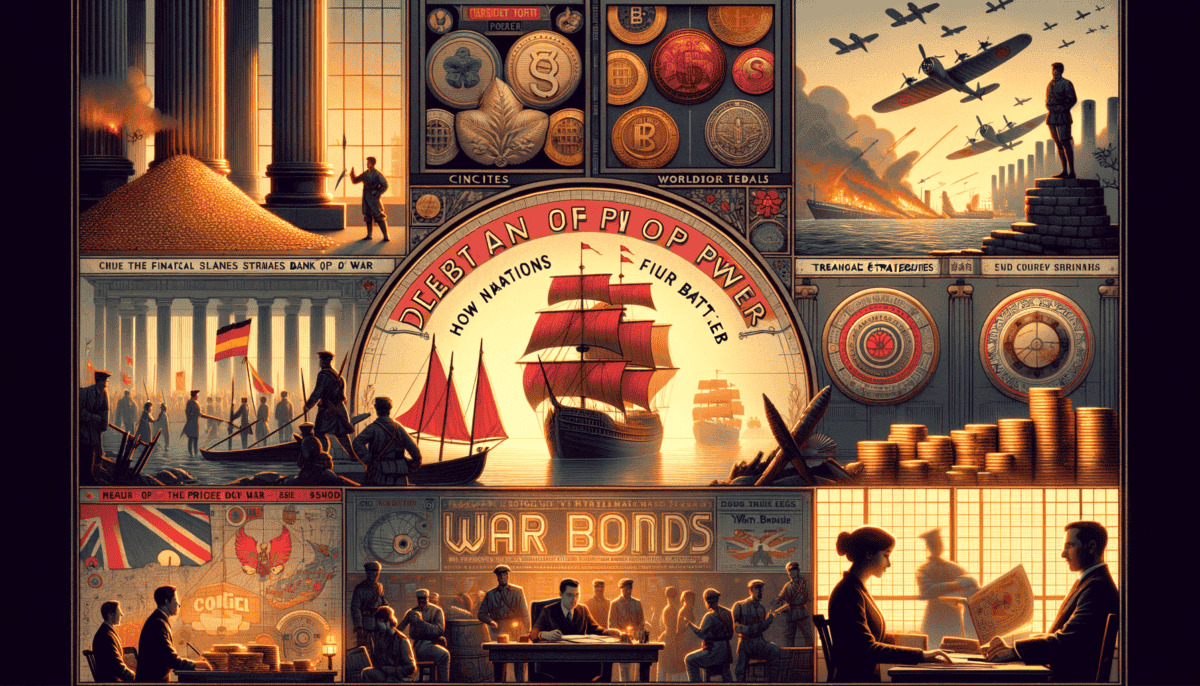Seeds of Conflict
Marcus stood at the edge of the Roman Forum, watching soldiers march past with their shiny armor and red cloaks. He was just a young boy, but he knew these brave men needed money to fight.
"Father, how does Rome pay for all these soldiers?" Marcus asked, tugging on his father's toga.
His father, Lucius, a respected senator, smiled down at him. "That's a very good question, my son. Come, let me show you something special."
They walked through the bustling marketplace, where coins clinked and merchants called out their wares. Lucius pulled out a silver denarius coin and held it up to the sunlight.
"See this coin? This is how Rome builds its armies. Every citizen pays taxes with coins like these."
Marcus's eyes widened. "But there must be thousands of soldiers! That's a lot of coins!"
"Indeed," Lucius chuckled. "And sometimes, when Rome needs more money quickly, we borrow it."
The Roman Money Box
Rome had clever ways to pay for its wars:
• Taxes from citizens and conquered lands
• Silver and gold from mines
• Borrowed money from wealthy Romans
• Plunder taken in battle
• Special war taxes when needed
"But father," Marcus frowned, "what happens when we can't pay it all back?"
Lucius's face grew serious. "That's the tricky part, my boy. Sometimes Rome struggles with debt. Just like when you borrow toys from your friend Claudius – you must always give them back, right?"
Marcus nodded eagerly. He remembered borrowing Claudius's wooden sword last week.
"Well, nations are the same. When they borrow money, they must pay it back. If they don't, it can cause big problems."
Growing Pains of an Empire ️
As they walked home through the crowded streets, Marcus saw more soldiers preparing for a new campaign. Their weapons and armor gleamed in the setting sun.
"Will Rome always need money for wars?" Marcus asked quietly.
"As long as there are battles to fight, armies will need support," Lucius replied. "But remember this – the true strength of Rome isn't just in its gold or weapons. It's in the hearts and minds of its people."
That night, as Marcus lay in bed, he thought about the coins, the soldiers, and his father's words. He understood now that even the mightiest empire needed more than just brave warriors – it needed smart ways to pay for its power.
A messenger's horn sounded in the distance. Tomorrow would bring new challenges, new battles, and new lessons about the cost of building an empire. But for now, young Marcus drifted off to sleep, dreaming of shining armies and clinking coins, while Rome's great wheels of power turned steadily onward.
The Golden Price of Empire
The sun blazed hot over the Spanish galleon as it cut through the waves. Captain Diego stood at the helm, watching his crew load heavy chests onto the ship. Each one was filled with gold from the New World.
“Look at all this treasure!” young Pedro exclaimed. He was learning to be a sailor, just like his father.
“Yes, mi hijo,” Captain Diego smiled. “But this gold comes with a price.”
The Problem with Too Much Gold
“But Captain,” Pedro looked confused, “isn’t gold good? Won’t it make Spain rich?”
Diego sat down next to the boy. “Let me tell you a story about King Philip and his big problem.”
“King Philip had lots and lots of gold. But he spent it all on wars. He needed ships, soldiers, and weapons. Every time more gold came from the New World, he spent it right away!”
“Having gold is good, Pedro. But spending it wisely is better.” – Captain Diego
The Spanish Money Problem
The things Spain bought with their gold:
• Big ships for the navy
• Armies to fight wars
• Fine palaces for the king
• Fancy things from other countries
• More wars in Europe
“But why did they keep fighting wars?” Pedro asked, helping to tie down a chest.
“They wanted to be the strongest empire,” Diego explained. “But wars are like hungry monsters – they always want more gold!”
The Big Lesson
As the sun set, turning the sea to liquid gold, Pedro watched the last chest being secured.
“I think I understand now,” he said slowly. “Just having lots of gold doesn’t make you rich if you spend it all.”
Diego patted the boy’s shoulder. “That’s right! And Spain learned this lesson the hard way.”
The ship creaked as it turned toward home. Pedro looked at the heavy chests, thinking about how something so shiny could cause so many problems.
That night, as stars sparkled above the dark ocean, Pedro wrote in his journal: “Today I learned that having treasure is not enough. You must also be wise about how you use it.”
The waves rocked the ship gently as it sailed on through the night, carrying its golden cargo and the weight of an empire’s future. More ships would follow, bringing more gold, but would Spain learn to use it better? Only time would tell.
Birth of a Nation’s Treasury
The cold winter wind howled through Valley Forge. Alexander Hamilton sat by candlelight, writing quickly. His quill scratched across the paper as he worked on a very big problem.
A Young Nation’s Money Troubles
“Mr. Hamilton,” George Washington called out as he entered the tent. “What news about our funds?”
Hamilton looked up from his papers. “It’s not good, sir. Our soldiers need food and warm clothes. But our money is worth less and less each day.”
The Continental Congress had printed lots of paper money called “Continentals.” But this money wasn’t worth much anymore. People didn’t trust it.
“Not worth a Continental” became a saying when something had no value at all!
Hamilton’s Big Idea
“Sir,” Hamilton stood up excitedly, “I have a plan! We need three things to make our new country strong:”
• A national bank to keep our money safe
• A way to pay back what we borrow
• Good credit so people will trust us
Building Trust in America
Washington smiled. “Tell me more about this national bank.”
“It will be like a big piggy bank for our whole country,” Hamilton explained. “We’ll pay back all our war debts. This will show everyone that America keeps its promises!”
Some people didn’t like Hamilton’s ideas. They thought the bank would be too powerful.
“But think about it,” Hamilton said to Washington. “If we want to be a strong nation, we need people to trust our money and our word.”
Making It Work
Years later, a young clerk at the First Bank of the United States picked up an old diary. Inside, he found Hamilton’s notes from that cold night at Valley Forge.
“Amazing,” he whispered. “This is how our country learned to handle money wisely.”
The clerk looked at the strong stone walls of the bank. America had grown from a poor group of colonies into a nation that could stand on its own. And it all started with Hamilton’s late-night planning in a cold winter tent.
Outside the bank’s windows, a busy Philadelphia street hummed with life. Merchants traded, ships came and went, and American coins jingled in people’s pockets. Hamilton’s dream of a strong American economy had come true.
The World at War’s Edge
The year was 1914. The streets of London buzzed with worry. Big posters on walls asked people to help pay for a war that would change everything.
Piggy Banks for Victory
Little Sally Jones stood on her tiptoes to see the colorful war bond poster. “Mama, what’s that?” she asked.
“That’s how we help our soldiers,” her mother explained. “We give our money to the government now, and they promise to pay us back later with a bit extra.”
All across Britain, America, and other countries, people bought war bonds. It was like everyone was putting their pocket money together to help win the war.
“Every penny counts in winning the war!” became a popular saying during World War I.
A World of Change
The war was bigger than any before it. Countries needed:
• More guns and ships than ever before
• Food for millions of soldiers
• New things like planes and tanks
Everyone Helps Out
Mrs. Thompson from the baker’s shop bought war bonds every month. “It’s not much,” she said, “but it helps our boys fight.”
Even children helped! They saved their pennies and bought special stamps that turned into war bonds.
When World War II came along twenty years later, countries remembered these lessons. They made even more war bonds!
New Ways to Pay
“Look, Tommy!” Sally showed her little brother a war bond certificate. “This piece of paper helps keep us safe!”
The government found clever ways to get money:
– They asked movie stars to tell people about war bonds
– They put up posters everywhere
– They even had special radio shows about helping the war effort
Working Together
“When will we get our money back?” Tommy asked.
“In a few years,” Sally explained. “But that’s not why we’re doing it. We’re doing it to help everyone!”
As the sun set over London, Sally and Tommy walked home. In their pockets, they carried their savings stamps, proud to be helping their country. The whole world was changing, and even children could be part of making things better.
Digital Dollars and Modern Wars
The sun rises over a busy city filled with computers and smartphones. Money moves faster than ever before!
Meet Tim the Tech Wizard ♂️
“Look at this, dad!” Tim points to his computer screen. “Money can zoom across the world in seconds now!”
Tim’s father nods. “When I was young, we had to wait days for money to move from one country to another. Now it’s as fast as sending a text message!”
New Money, New Rules
Countries today use special computer systems to move money. It’s like a giant video game, but with real money!
Tim’s teacher explains to the class:
• Ways countries pay for modern wars:
- Digital bank transfers
- Special computer networks
- Electronic payments
- Digital currencies
- International money systems
Cyber Warriors ️
“What’s a cyber warrior?” asks Sarah, Tim’s classmate.
“They’re special computer experts who protect our money and information,” explains Ms. Rodriguez, their teacher. “They fight battles using keyboards instead of tanks!”
Global Money Team
Countries work together in new ways now. They share computer systems and help each other track money.
“It’s like a big puzzle,” Tim says. “Everyone has to work together to make it work!”
“The world is connected like never before. We’re all part of one big digital family!”
Future Money
Tim dreams about the future. “Maybe someday we’ll use space money!” he laughs.
His father smiles. “Who knows? The way we use money keeps changing. That’s why it’s important to learn about new technology.”
Working Together in New Ways
Ms. Rodriguez gathers her class for one final lesson. “Remember, kids, technology makes it easier for countries to work together. But it’s still important to use money wisely!”
As Tim walks home with his tablet under his arm, he thinks about how different things are now compared to the old days. Money moves at the speed of light, and wars are fought with computers as much as with soldiers.
The street lights flicker on as the city hums with digital activity. Somewhere, invisible electronic signals carry money across the globe, helping countries protect themselves in new and different ways.
The Price We All Pay
Little Maria sits at her grandmother’s kitchen table, looking at old photos. ️
Family Stories
“Grandma,” Maria asks, “why do these old pictures look so sad?”
Grandma Elena picks up a faded photograph. “This was taken after the big war, sweetie. Everyone had to help pay for it.”
“Even kids like me?” Maria’s eyes grow wide.
“Yes, dear. When countries borrow money for wars, everyone helps pay it back – even children and their children’s children.”
The Piggy Bank Story
Grandma Elena pulls out Maria’s pink piggy bank.
“Think of it like this: If you borrow money from your piggy bank today, you’ll have less to spend tomorrow.”
Countries work the same way. When they spend lots of money on wars, they have less for:
- Schools and teachers
- Parks and playgrounds
- Hospitals and doctors
- Roads and bridges
- Help for people who need it
Making Better Choices
Maria’s teacher, Mr. Chen, talks to his class about peace.
“What if countries spent their money on helping each other instead of fighting?” he asks.
Learning from the Past
Maria finds her history book. “Look, Grandma! It shows how wars changed through time.”
“Yes, from Roman soldiers to modern computers,” Grandma Elena nods. “But one thing stays the same – wars always cost more than just money.”
Building a Better Tomorrow
Maria draws a picture of her dream world. It has:
– People helping each other
– Countries being friends
– Money spent on good things
– Peace everywhere
A New Hope ⭐
“Can we make the world better?” Maria asks her grandmother.
Grandma Elena hugs her tight. “Of course we can! It starts with understanding our past and making smart choices for our future.”
As the sun sets outside their window, Maria and her grandmother look at more old photos. They tell stories of both hard times and hope. Maria learns that while wars and money are complicated things, the most important thing is how we treat each other.
The evening stars twinkle as Maria dreams of a world where countries solve problems with kindness instead of conflicts. She knows now that every choice about money and war affects real people – just like her, her family, and her friends.
Perhaps the most valuable lesson isn’t about money at all – it’s about working together to build a peaceful world for everyone.






